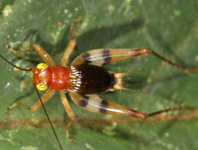Abstract
Two new species, Prodontorhabditis robustus sp. n. and P. grandistoma sp. n. are described and illustrated from rotting banana rhizome and decaying organic matter respectively. P. robustus sp. n. is characterized by thin and slender females with L= 490–625 µm; a= 25.8–34.7; b= 4.9–6.4; c= 2.4–3.7, an arched cheilostom with curved walls bearing basal dorsal and subventral denticles at the same level, males with 20–23 µm long, robust spicules with prominent dorsal velum and lateral spurs at its bifurcated distal tip and gubernaculum with attenuated proximal end. P. grandistoma sp. n. is characterized by plump females with L= 440–552 µm; a= 23.9–25.5; b= 4.4–5.7; c= 2.9–4.2, a long, narrow stoma of length 6–7 times diameter; the cheilostom straight but, wider anteriorly with a basal dorsal denticle and anterior subventral denticles, rectum with dilated lumen, males with 17–20 µm long, relatively slender spicules and a terminally indented bursa. This is the first report of Prodontorhabditis species from India. An updated list of species, a key to their identification and a compendium of their morphometrics and diagnostic features is presented.
References
Andrássy, I. (1983) A taxonomic review of the suborder Rhabditina (Nematoda– Secernentia). Orstom, Paris, 241 pp.
De Maeseneer, J. & d’Herde, J. (1963) Me´thodes utilise´es pour l’e´tude des anguillules libres du sol. Revue d’Agriculture, 16, 441–447.
Dougherty, E.C. (1955) The genera and species of the subfamily Rhabditina Micoletzky, 1922 (Nematoda). A nomenclatorial analysis– including an addendum on the composition of the family Rhabditidae Örley, 1880. Journal of Helminthology, 29, 105–152.
https://doi.org/10.1017/S0022149X00024317
Eisenback, J.D. (1985) Techniques for preparing nematodes for scanning electron microscopy. In: Barker, K.R., Carter, C.C. & Sasser, J.N. (Eds.), An advanced treatise on Meloidogyne. Vol. II. Methodology. A cooperative publication of the Department of Plant Pathology and the United States Agency for International Development. North Caarolina Sate University Graphics, Raleigh, North Carolina, pp. 79–105.
Flegg, J.J.M. (1967) Extraction of Xiphinema and Longidorus species from soil by a modification of Cobb’s decanting and sieving technique. Annals of Applied Biology, 60, 420–437.
https://doi.org/10.1111/j.1744-7348.1967.tb04497.x
Gagarin, V.G. (2000) Nematode fauna of manure and compost in Yaroslavl oblast (Russia). Zoologicheskii Zhurnal, 79, 1260–1274.
Hooper, D.J. (1970) Handling, fixing, staining and mounting nematodes. In: Southey, J.F. (Ed.), Laboratory methods for work with plant and soil nematodes. Great Britain. Ministry of Agriculture, Fisheries and Food. Technical bulletin 2. 5th Edition. H.M.S.O, London., pp. 39–54.
Kiontke, K., Manegold, A. & Sudhaus, W. (2001) Redescription of Diplogasteroides nasuensis Takaki, 1941 and D. magnus Volk, 1950 (Nematoda: Diplogastrina) associated with Scarabaeidae (Coleoptera). Nematology, 3, 817–832.
https://doi.org/10.1163/156854101753625317
Osche, G. (1952) Systematik und Phylogenie der Guttung Rhabditis (Nematoda). Zoologische Jahrbücher, Systematik, 81, 190–280.
Schneider, W. (1937) Freilebende Nematoden der Deutschen Limnologischen Sundaexpedition nach Sumatra, Java und Bali. Archiv für Hydrobiologie, Supplement, 15, 30–108.
https://doi.org/10.1163/187529259X00381
Seinhorst, W. (1959) A rapid method for the transfer of nematodes from fixative to anhydrous glycerin. Nematologica, 4, 67–69.
Sudhaus, W. (1974) Zur Systematik, Verbreitung, Ökologie und Biologie neuer und wenig bekannter Rhabditiden (Nematoda). 1. Teil. Zoologische Jahrbücher, Systematik, 101, 173–212.
Sudhaus, W. (2011) Phylogenetic systematisation and catalogue of paraphyletic “Rhabditidae” (Secernentea, Nematoda). Journal of Nematode Morphology and systematics, 14 (2), 113–178.
Sudhaus, W. & Fitch, D. (2001) Comparative studies on the phylogeny and systematics of the Rhabditidae (Nematoda). Journal of Nematology, 33, 1–70.
Timm, R.W. (1961) Prodontorhabditis n. gen. (Rhabditidae, Prodontorhabditinae n. subfam.), a new soil nematode from East Pakistan. Proceedings of the Helminthological Society of Washington, 28, 115–117.

